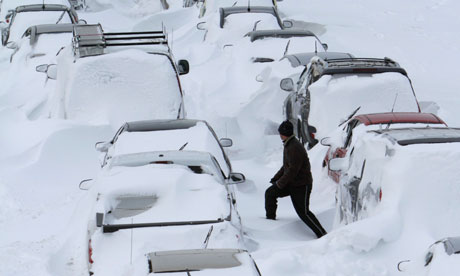Insurance Company's Survey Finds Drivers Unprepared For Emergencies
 According to a new survey by State Farm Insurance and KRC Research, more than sixty percent of drivers had some sort of "junk" (non-emergency supplies) in their trunk ranging from extra clothes and shoes to used food or drink containers. The findings serve as a warning to people who may experience roadside emergencies this winter, only to find themselves ill equipped to meet such challenges. While 99 percent of drivers had at least one emergency supply in their vehicle, such as spare tire or jumper cables, a mere nine percent carried all the essential emergency roadside supplies, including:
According to a new survey by State Farm Insurance and KRC Research, more than sixty percent of drivers had some sort of "junk" (non-emergency supplies) in their trunk ranging from extra clothes and shoes to used food or drink containers. The findings serve as a warning to people who may experience roadside emergencies this winter, only to find themselves ill equipped to meet such challenges. While 99 percent of drivers had at least one emergency supply in their vehicle, such as spare tire or jumper cables, a mere nine percent carried all the essential emergency roadside supplies, including:
- Jumper cables
- Spare tire
- Hazard triangle/road flares
- Flashlight
- First aid kit
- Water
- Blanket
"Even on a relatively short trip, you can find yourself stranded for several hours. From icy waters splashing up on Lake Shore Drive in Chicago to fog covering the Golden Gate Bridge in San Francisco, it's important to be prepared," said Robert Medved, Safety Expert with the insurer. "These new findings highlight the importance of having the right emergency equipment so people can safely get back on the road faster."
Medved also recommends drivers check at least twice a year to ensure the equipment is in working order. This means spare tires are properly inflated, first-aid supplies are current, all other supplies are fully stocked, and the cell phone charger is compatible with either a power outlet or an USB port in your car. Communication capability can be the number one lifeline in some roadside emergency cases.
How Your Junk Stacks Up: New survey findings also revealed that sedan drivers (63 percent) are less likely to carry emergency supplies compared to SUV and truck owners (75 percent and 73 percent respectively). Also, only two in five drivers said they check that the emergency supplies in their vehicle are working at least twice a year, in line with what is recommended.
Advice for Drivers: If you are stranded on the road, follow these tips:
- Pull off the highway (if possible), turn on your hazard lights and use a road flare or reflectors to signal attention
- If you have a cell phone, call 911 and describe your location as precisely as possible -- Follow any instructions from the dispatcher
- Remain in your vehicle so help can find you
- Run your vehicle's engine and heater about ten minutes each hour to keep warm
- Open a downwind window slightly for ventilation and clear snow from the exhaust pipe to prevent carbon monoxide poisoning
- Don't waste your vehicle's battery power; balance electrical energy needs (lights, heat and radio) with supply
- At night, turn on an inside light when you run the engine so help can see you
- Keep emergency supplies like road flares, a flashlight, blanket, windshield scraper, jumper cables, spare tire, and a first aid kit in your vehicle or trunk at all times
- Keep your fuel tank at least half-full at all times during bad weather
 According to a new survey by State Farm Insurance and KRC Research, more than sixty percent of drivers had some sort of "junk" (non-emergency supplies) in their trunk ranging from extra clothes and shoes to used food or drink containers. The findings serve as a warning to people who may experience roadside emergencies this winter, only to find themselves ill equipped to meet such challenges. While 99 percent of drivers had at least one emergency supply in their vehicle, such as spare tire or jumper cables, a mere nine percent carried all the essential emergency roadside supplies, including:
According to a new survey by State Farm Insurance and KRC Research, more than sixty percent of drivers had some sort of "junk" (non-emergency supplies) in their trunk ranging from extra clothes and shoes to used food or drink containers. The findings serve as a warning to people who may experience roadside emergencies this winter, only to find themselves ill equipped to meet such challenges. While 99 percent of drivers had at least one emergency supply in their vehicle, such as spare tire or jumper cables, a mere nine percent carried all the essential emergency roadside supplies, including: